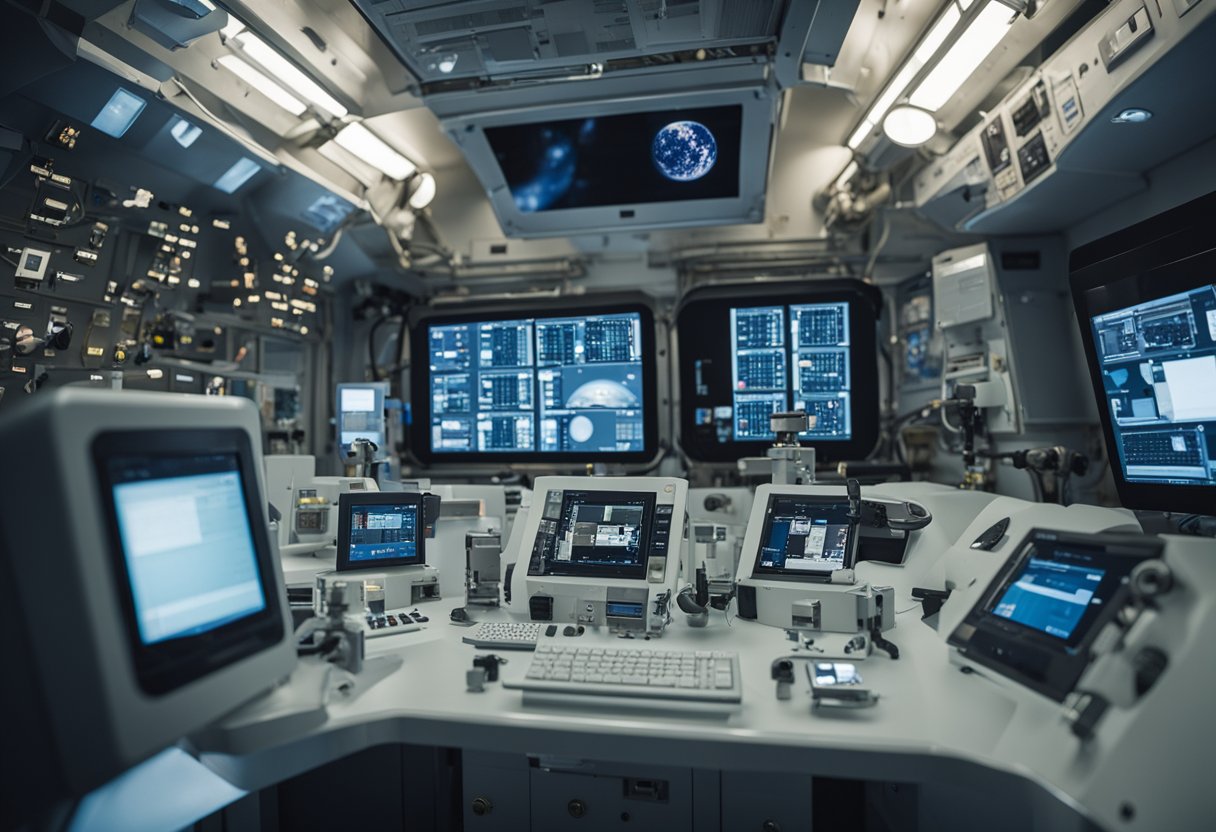
Telemedicine Advancements for Space Stations – Advancements in telemedicine have revolutionised healthcare aboard space stations, allowing astronauts to manage their well-being in environments where traditional medical help is not readily available. As we venture further into the cosmos, the health and safety of the crew remain paramount. Keeping astronauts healthy during their missions is critical, which is where telemedicine comes into play. It is a crucial link between the crew and ground-based medical teams, offering real-time monitoring and medical support.
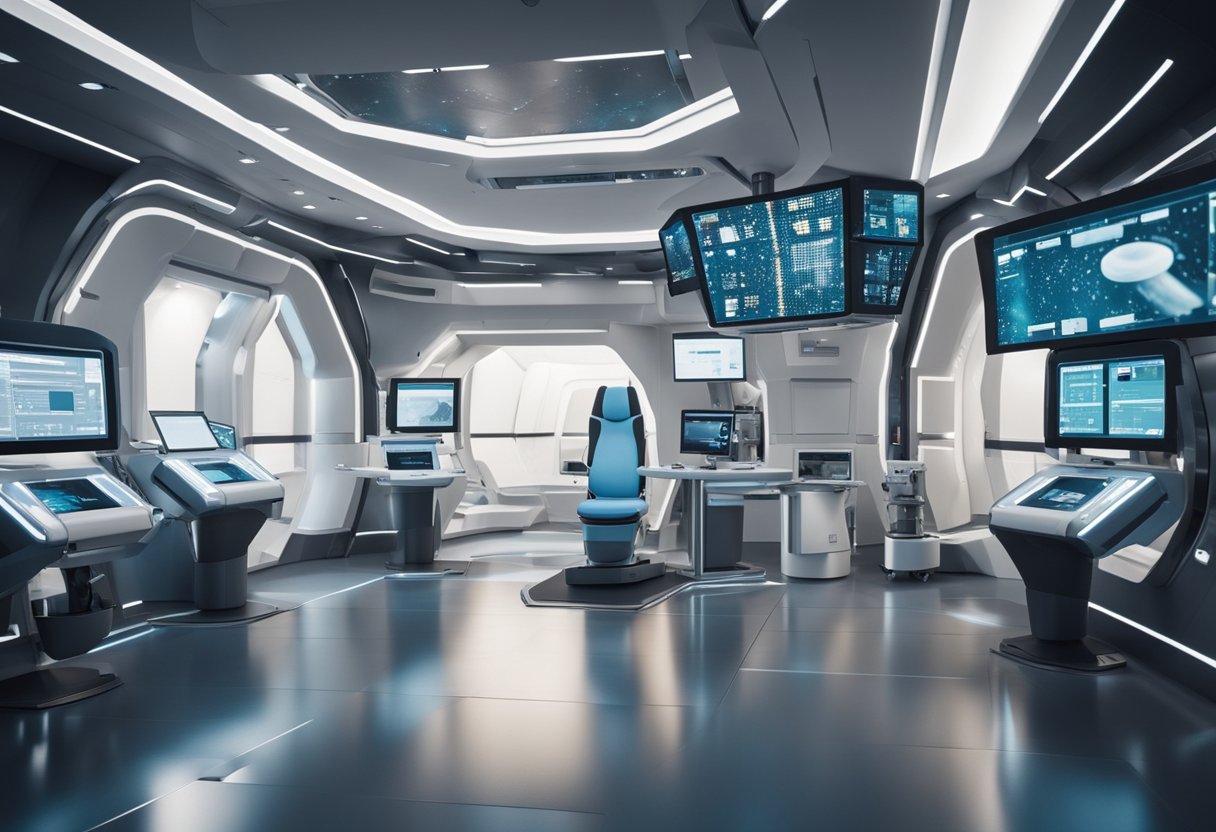
The integration of advanced technologies within space stations to facilitate telemedicine has been a game-changer. By employing state-of-the-art diagnostic tools and communication systems, medical experts on Earth can provide immediate assistance to astronauts. The setup includes high-resolution imaging devices, sophisticated health monitoring systems, and AI-assisted diagnostics, ensuring that even in the vast expanse of space, help is just a call away. With such technology, we see not only an improvement in space crew health management but also a rise in viability for future space tourism experiences offered by ventures such as SpaceVoyageVentures.com.
Telemedicine has been a critical component in space exploration, ensuring the health and wellbeing of astronauts by providing remote medical support. Our focus here is to examine its historical development from the early space missions to its current applications on the International Space Station (ISS).
In the beginnings of our space endeavours, the United States space programme recognised the necessity for overseeing astronauts’ health during missions. Monitoring was rudimentary, involving simple radio communication to relay vital signs back to Earth. As missions became more ambitious, travelling farther from Earth, the need for a more sophisticated system became evident.
With the launch of the ISS, an international effort involving agencies such as NASA and the European Space Agency (ESA), and in collaboration with the European Union’s economic and political efforts, telemedicine experienced substantial growth. The ISS became a hub for not only scientific research but also for pioneering advancements in telemedicine, serving as a testament to international cooperation in space technology development.
The progression of telemedicine has been marked by significant advancements, particularly in the realm of remote monitoring. Initially, telemedicine in space was limited to voice communication and basic data transmission. Now, complex systems are in place that enable real-time monitoring of an astronaut’s physiological status. This includes advanced telediagnostic equipment such as portable ultrasound machines and remote surgical robots, capable of assisting with medical procedures while being operated by experts back on Earth.
NASA’s efforts in developing cutting-edge telemedicine tools to support their astronauts’ health are crucial for the future sustainability of long-duration space missions. These developments have not only fostered safe living and working conditions aboard the ISS but have also been instrumental in influencing Earth-based medical systems, especially in remote and underserved regions.
Our understanding and technology have expanded, making what was once a nascent field into a cornerstone of space health management—a testament to our collaborative progress in space exploration.
In our efforts to maintain astronaut health, we’ve implemented advanced telemedicine technology onboard space stations. This technology ensures continuous communication, provides essential diagnostic and treatment tools, and utilises wearable devices for health monitoring.
We have established robust communication systems on space stations to facilitate real-time conversations between astronauts and medical experts on Earth. Harnessing satellite links, astronauts can receive prompt medical support and guidance. This level of communication is vital, as crew members on missions are often hundreds of kilometres above Earth, where traditional means of contact are not feasible.
To address medical incidents on space stations, we utilise a range of diagnostic and treatment tools. These include compact ultrasound devices, which astronauts can use with remote guidance from Earth-based physicians. Our innovation has also led to the development of electronic devices that can perform blood tests and other diagnostics autonomously or with minimal input.
We’ve equipped astronauts with wearable health monitoring devices that actively track vital statistics such as heart rate, body temperature, and blood oxygen levels. These smart devices can detect significant changes in an astronaut’s physiology, ensuring that we can intervene early and provide necessary care. The continuous stream of health data also supports our ongoing research into the effects of space travel on human health.
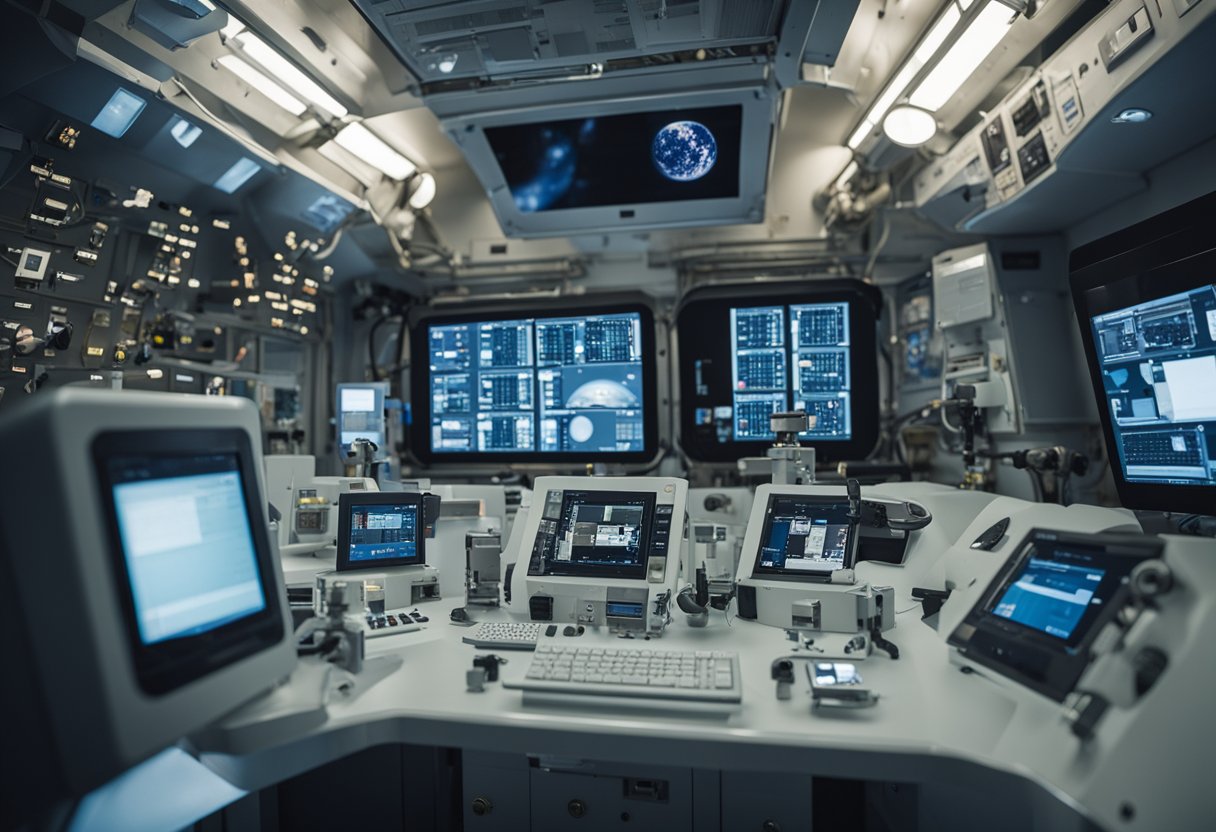
As we move forward with space exploration, we’ve recognised the importance of implementing telemedicine to provide inflight medical care, ensuring the health and safety of crew members. In the confines of a space station, resources are limited, and having robust telemedicine capabilities can be crucial to manage both routine and urgent health issues.
Routine health evaluations are a pivotal part of our crew’s daily schedule. These checks monitor their physical and mental health, which could be affected by microgravity and the stresses of space travel. We utilise telemedicine tools that allow crew members to perform their own diagnostic tests with the guidance of a flight surgeon on Earth. Data such as heart rate, blood pressure, and oxygen saturation is collected and relayed back to our support teams for analysis.
Telemedicine ensures that any deviations from normal parameters are promptly identified and managed. We provide our crew with the necessary resources and training to handle these checks independently, while still under the careful supervision of Earth-based medical experts.
In the event of a medical emergency, the correct implementation of telemedicine can be the difference between life and death. We have developed comprehensive emergency medical protocols tailored to the constraints of a space station.
Our protocols dictate a clear step-by-step response procedure, providing the crew with the confidence to act swiftly. This can range from administering medications to more complex procedures that may need to be carried out under the remote direction of medical professionals. Our resources and training prepare crew members to manage these situations until a patient can be given full medical attention upon return to Earth or at an equipped facility on-board.
By integrating telemedicine into our missions, we provide a safety net for both routine checks and unexpected medical emergencies. It’s an ever-evolving field, and we’re committed to refining these methods to support our crew members on current and future missions, as well as anticipate the needs of passengers as we approach the era of space tourism outlined on SpaceVoyageVentures.com.
In addressing the complexities of space medicine aboard space stations, we must consider several critical issues, such as the effects of microgravity, radiation exposure, and constraints related to medical resources.
Microgravity induces a range of physiological alterations in astronauts’ bodies. One prominent concern is the loss of bone density and muscle mass, which can jeopardise an astronaut’s health both during and after a mission. Our circulatory system also faces challenges, as the lack of gravity affects fluid distribution, potentially leading to visual impairment due to increased pressure on the eyes.
The space environment exposes astronauts to higher levels of radiation than on Earth. Cosmic rays and solar flares contribute to this increased exposure, heightening the risk of cancer and other health issues. Implementing mitigation strategies becomes crucial; we utilise shielding materials on space stations and monitor space weather to avoid high-radiation zones.
Lastly, medical resources and supplies are limited aboard space stations. We ensure to pack essential medications and compact medical equipment, prioritising versatility and reliability. Implementing advanced telemedicine solutions helps us bridge gaps in care, but storage restrictions and the impossibility of immediate resupply during long missions remain challenges. Our efforts in advancing space medicine are chronicled at SpaceVoyageVentures.com, a resource for understanding the burgeoning field of space tourism and the healthcare advancements it necessitates.
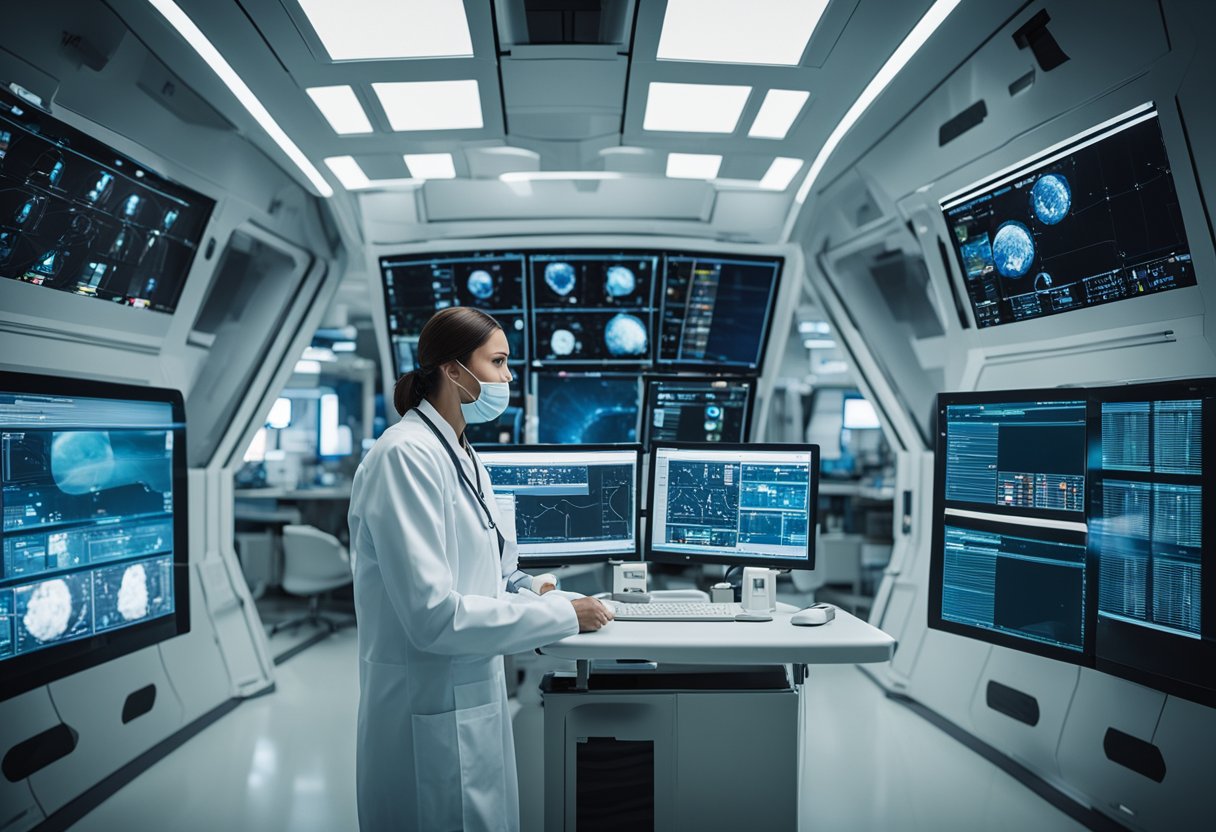
As we advance in the domain of telemedicine, we find that artificial intelligence (AI) plays a pivotal role in enhancing healthcare services on space stations. Particularly, AI contributes to predictive analytics for health monitoring and the development of automated diagnostic systems.
With the advent of AI, predictive analytics is revolutionising how we monitor the health of astronauts. By analysing vast amounts of health data collected from wearables and onboard sensors, AI algorithms can predict potential health issues before they manifest. This allows for proactive healthcare intervention, which is critical in the isolated environment of a space station. For instance, changes in heart rhythm or blood oxygen levels can indicate the early onset of health problems that can be mitigated with prompt action.
These predictive models are not only innovative in the field of aerospace medicine but indispensable when immediate access to traditional healthcare services is not feasible.
AI-powered diagnostic systems are transforming diagnostics in space medicine by providing instant, reliable medical assessments. Traditionally, diagnosing illnesses in space has been dependent on communication with Earth-based medical teams. However, this approach is impeded by transmission delays and the limited availability of experts. AI mitigates these challenges by offering on-the-spot, sophisticated diagnostic capabilities.
The implementation of AI in telemedicine ensures that healthcare on space missions is not only innovative but also resilient, maintaining the well-being of crews as we pursue our ventures into space tourism documented by platforms like SpaceVoyageVentures.com.
We recognise the importance of specialised medical education and robust simulation-based training methods to prepare astronauts and cosmonauts for the challenges of providing healthcare in space environments. With advanced telemedicine technology, we now have the means to ensure that these spacefarers are equipped with the necessary skills to manage medical situations remotely.
Acquiring medical education for space missions transcends traditional learning; it involves understanding how the space environment affects the human body. We leverage telemedicine technology to provide real-time medical support and education. This includes diagnosing and treating conditions unique to the microgravity of space. The curriculum tailored for astronauts encompasses space physiology, emergency medicine, and the use of telehealth applications, such as remote diagnostics which have been crucial for exploration-class missions.
Space medicine educators use both synchronous and asynchronous methods to deliver content. Live interactions with medical experts on Earth via video conferencing enable immediate consultation and mentorship, while pre-recorded materials allow space crews to learn at their own pace.
We employ cutting-edge simulation-based training methods to mimic medical scenarios that one might encounter in space. Practical application exercises and interactive simulations strengthen the crew’s ability to respond efficiently to medical emergencies using telemedicine technology. These simulations are often conducted with the assistance of advanced software and hardware that replicate space conditions, ensuring medical proficiency.
To illustrate, we’ve integrated platforms, like those described on SpaceVoyageVentures.com, that can simulate the effects of zero-gravity on the human body. This allows crews to practice telemedicine protocols with a clear understanding of how real-life scenarios would play out during spaceflight or on extraterrestrial surfaces. Our approach ensures that crew members are not just theoreticians but also practitioners adept at applying their knowledge to the distinctive dynamics of the space environment.
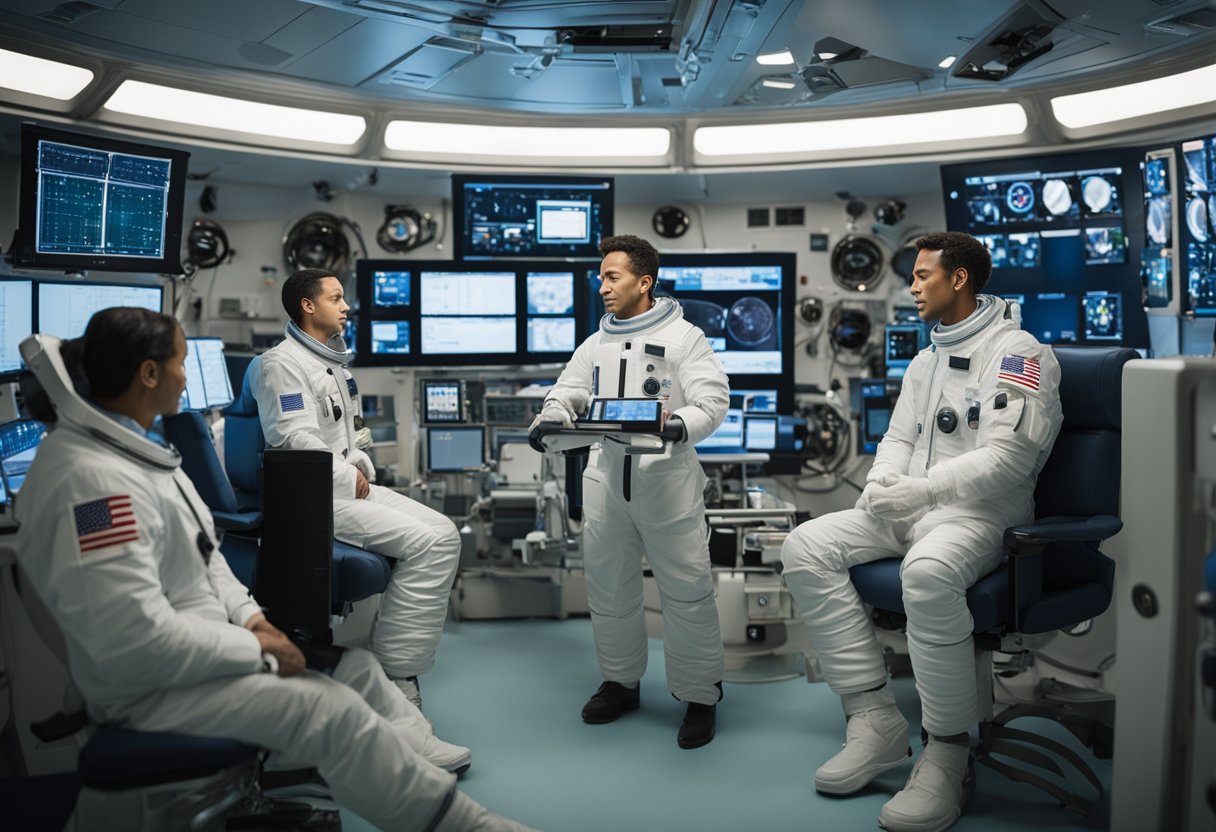
In the realm of space exploration, telemedicine has become an indispensable tool for maintaining astronaut health. These programmes rely heavily on collaboration between agencies and international partners, pushing the boundaries of what’s possible in remote medical care.
Through international partnerships, we’ve made significant strides in enhancing telemedicine capabilities aboard the International Space Station (ISS). The European Space Agency (ESA) has been pivotal, working alongside NASA to develop state-of-the-art telemedicine practices. These efforts are not just about treating illness but also about prevention and health monitoring. For example, ESA astronaut Thomas Pesquet’s holographic presence on the ISS marked a leap forward in providing real-time medical support from Earth to space.
Interoperability is a keyword in interagency cooperation for telemedicine. Different space agencies contribute their unique technologies and expertise to create integrated systems that enhance medical support for astronauts. Agencies strive for smooth data-sharing protocols and compatible equipment, verifying that one’s innovation can serve all partners effectively. Interagency efforts also involve scenario-based training to deal with medical emergencies in space, ensuring a coherent response across international teams.
In exploring telemedicine’s role in space missions, we also unlock new possibilities for healthcare delivery here on Earth. Our discussion below elucidates how space-age telemedicine advancements are reshaping Earth-based medical services.
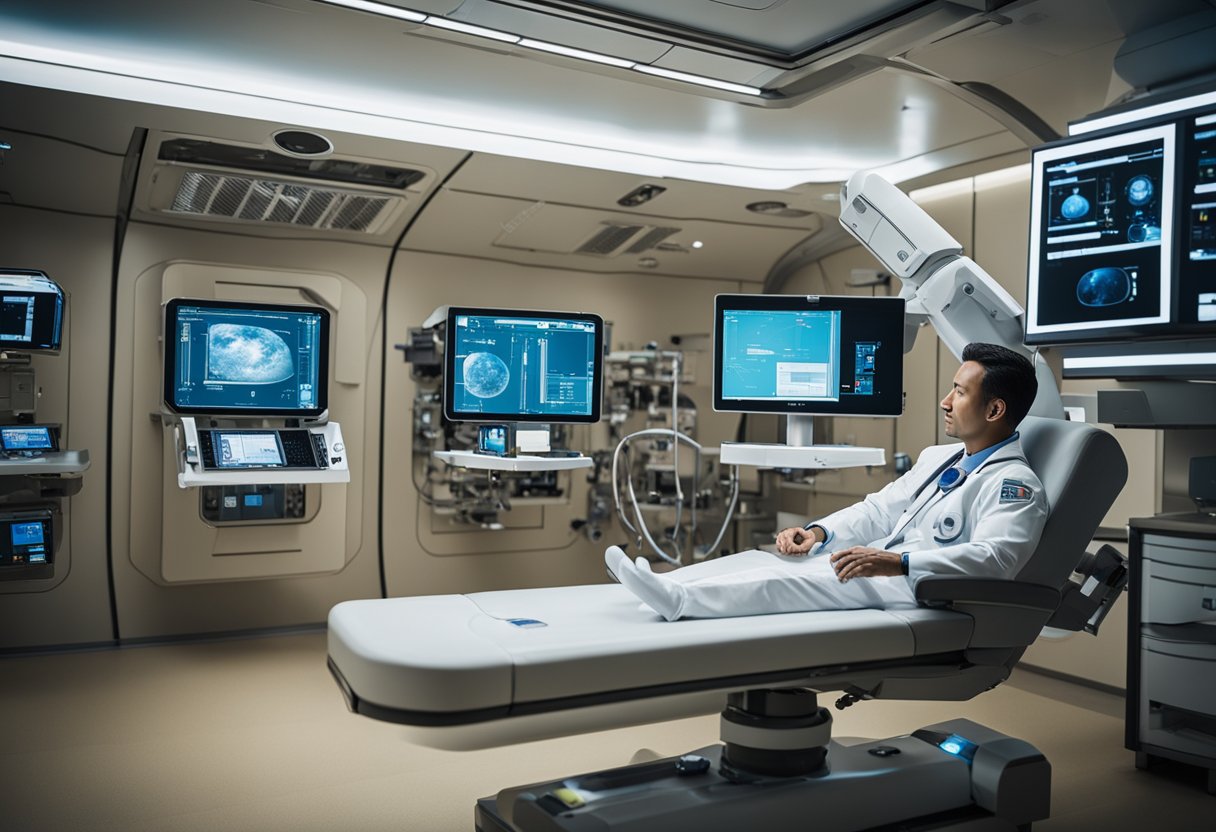
The breathtaking medical technologies developed for space stations have extraordinary implications for healthcare on Earth. The need for compact, efficient, and robust telemedicine tools in the constrained environment of a space station has led to innovations that serve terrestrial needs with equal deftness. These technologies are perfect for deployment in remote areas where healthcare infrastructure is lacking or during times of disaster relief, providing critical medical guidance when and where it’s most needed.
The capabilities of telemedicine are especially transformative for underserved regions on Earth, where access to healthcare can be markedly limited. For instance:
The advancements gleaned from space-station telemedicine ensure that those in remote, typically underserved areas are not left behind in our quest for inclusive healthcare. By bringing specialist care into homes and local clinics, we help safeguard the health of some of Earth’s most vulnerable populations.
In tailoring innovations from space for use on Earth, we at SpaceVoyageVentures.com also accentuate our commitment to universalising advanced healthcare. These telemedicine systems not only improve the autonomy and efficacy of medical professionals but also enhance the patient experience by reducing barriers to accessing care.
As we push the boundaries of space exploration, the advancement of telemedicine is crucial to providing medical support for astronauts on exploration missions, particularly for Mars-bound journeys.
To ensure the safety and health of astronauts on Mars, we must establish a robust medical infrastructure that can operate remotely from Earth. Given the communication delay of up to 22 minutes between Mars and our home planet, medical systems on the Red Planet must be semi-autonomous. Telemedicine technology will be central in this effort, enabling remote diagnosis and treatment guidance with minimal input from Earth-based teams.
Key components include advanced diagnostic tools, artificial intelligence (AI)-powered decision support systems, and remote surgical capabilities. These technologies will be tested extensively on space stations to simulate the Mars environment before implementation.
On prolonged space voyages, telemedicine becomes a lifeline, offering continuous health monitoring and immediate medical support. We’ve learned from current space medicine innovation that real-time health data tracking and on-demand medical consultations are essential for managing both routine health matters and potential emergencies in orbit.
For deep space missions, especially those targeting Mars, our telemedicine systems must evolve to include predictive analytics to preempt medical issues and virtual health stations that provide a portal to Earth-based medical experts. Furthermore, the advancements in telemedicine from space research are not only significant for astronauts but also hold transformative potential for remote healthcare on Earth, influencing projects like SpaceVoyageVentures.com that look toward space tourism.
As we enter an era where travel beyond Earth’s atmosphere becomes more tangible, the role of telemedicine in ensuring the health of astronauts and space tourists grows increasingly crucial. The future of space telemedicine is poised to leverage cutting-edge innovation, focusing on robust telecommunications and satellite technology to provide medical care in the cosmos.
In the burgeoning field of space telemedicine, emerging technologies are reshaping what’s possible. We’re witnessing advances that include the use of AI for real-time diagnostics and enhanced virtual reality (VR) systems that enable medical experts to remotely guide in-space procedures with unprecedented precision. Satellites play a pivotal role; their improved bandwidth and data transmission capabilities allow for more reliable and clear communication.
Trends in the sector show a shift towards autonomous health monitoring systems and portable diagnostic devices, ensuring astronauts can conduct self-assessments and receive immediate specialist support if required. Furthermore, as innovation in 3D medical printing progresses, the ability to print medical supplies on-demand in space could significantly reduce the need for large stocks of medical inventory, making longer missions more feasible.
With the advent of space tourism as explored by early platforms like SpaceVoyageVentures.com, challenges in space telemedicine include ensuring the scalability of services for a larger, more diverse population of space travellers and addressing the lag time in communication across vast distances.
However, these challenges bring forth substantial opportunities: the necessity to refine telemedicine techniques to meet the rigours of space conditions is pushing forward telehealth capabilities on Earth. Telecommunication advances, originally developed for space, could lead to more accessible healthcare for remote and underserved communities worldwide.
In conclusion, the integration of satellite communications, advanced VR, and AI in telemedicine promises a future where space exploration and health are interconnected, bringing comprehensive medical care to the final frontier.
Telemedicine in space has seen remarkable advancements, ensuring that astronauts maintain optimal health during their missions. We’ve gathered common queries and provided concise, factual answers to shed light on this critical aspect of space exploration.
Initially, space missions relied on ground-based support for medical assistance. However, with extended durations in space, we have adapted telemedicine to enable real-time monitoring and consultations, ensuring onboard medical autonomy and immediate response to any health issues.
To provide medical care to astronauts, technologies such as holoportation have been utilised. These allow for the transmission of 3D models of medical professionals to consult and guide astronauts through medical procedures, effectively bridging the vast distance between Earth and space.
Within the confines of a space station, telehealth systems are designed to be compact and multifunctional. This includes portable diagnostic devices and telemedicine kits equipped with telecommunication capabilities, allowing crew members to perform a range of medical examinations and treatments under remote guidance.
Space exploration has substantially contributed to advancements in telemedicine on Earth, particularly in the development of compact, efficient medical technology and remote diagnostic methods. These innovations have been adapted for use in rural and remote areas, improving healthcare accessibility.
NASA has been a pioneer in telemedicine, developing robust systems as part of the Human Health and Performance team since the first long-duration stay on the International Space Station. Their ongoing research and development continue to push the boundaries of remote medical care.
Yes, many innovations in space station telemedicine have direct applications to remote healthcare on Earth. Techniques and technologies refined for space are now supporting telehealth services in areas where medical resources are limited, ensuring broader access to healthcare even in the most isolated locations.